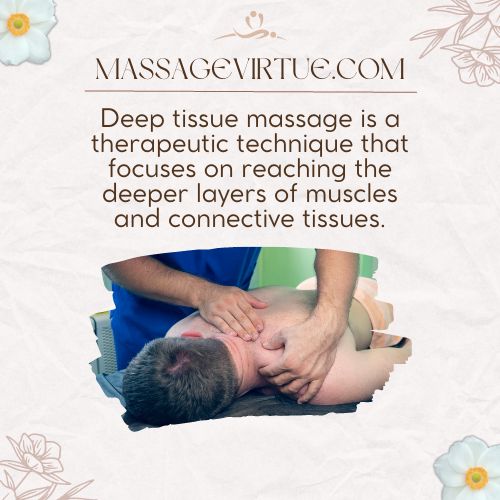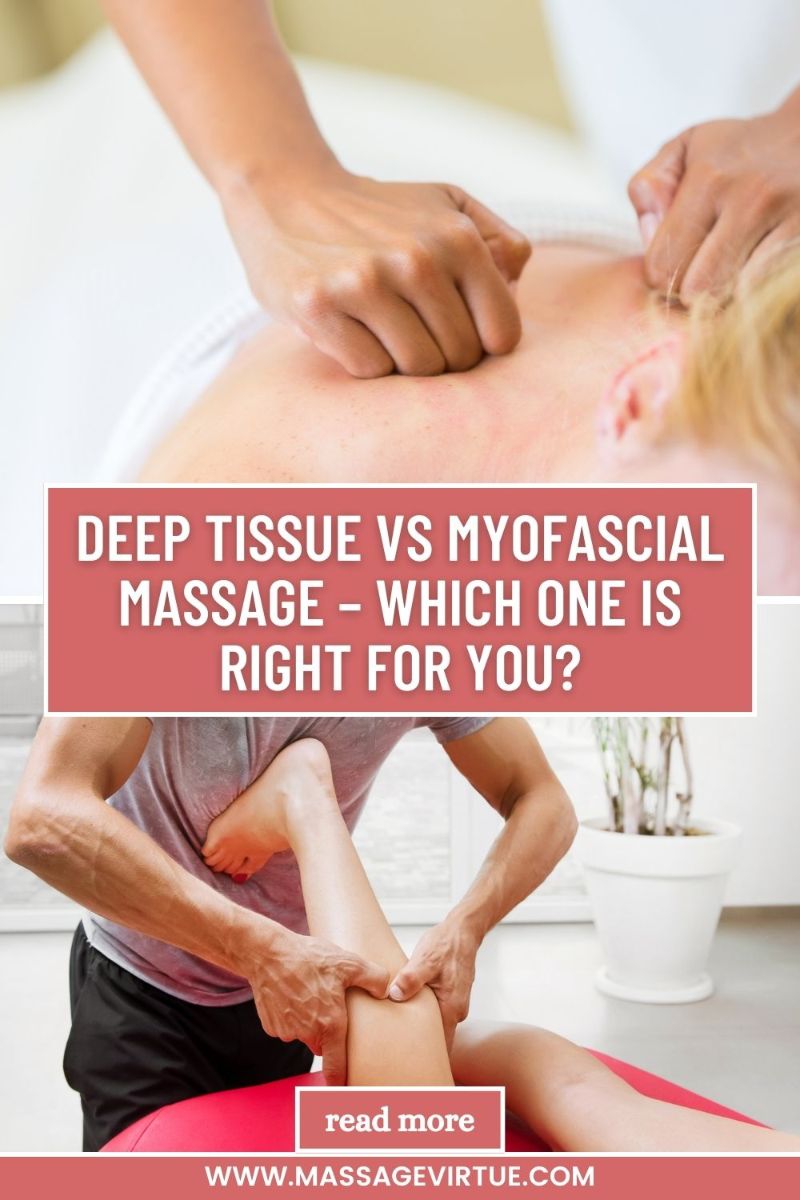When it comes to finding relief from muscle tension, chronic pain, or sports injuries, massage therapy is often a top choice.
Two popular types of massage therapy that you might have heard of are deep tissue massage and myofascial release.
While both offer potential benefits, they differ in their techniques and target areas.
In this article, we’ll dive into the world of deep tissue vs. myofascial massage, comparing their techniques, benefits, and risks, and helping you determine which one might be a better fit for your needs.
Myofascial Massage vs. Deep Tissue Massage – Comparison
| Aspect | Deep Tissue Massage | Myofascial Release |
| Focus | Deeper muscle layers | Fascia and connective tissue |
| Pressure | Firm, intense pressure | Sustained, gentle pressure |
| Technique | Targeting specific muscle knots | Stretching and releasing fascia |
| Purpose | Muscle pain and tension relief | Improving fascial mobility |
| Benefits | Effective for chronic pain | Enhances flexibility |
| Risks | Soreness and bruising are possible | Rare but possible discomfort |
| Ideal for | Individuals with muscle knots | Those with limited mobility |
What is a Deep Tissue Massage?
Deep tissue massage is a therapeutic technique designed to access and alleviate tension in the deeper layers of your muscles.

It involves the application of firm and sustained pressure on specific areas where muscle knots, also known as trigger points, may be causing discomfort.
Deep Tissue Massage Benefits
Deep tissue massage offers numerous benefits. Let’s explore some of them:
1. Pain Relief
Deep tissue massage excels at alleviating chronic muscle pain and discomfort.
Through precise targeting of muscle knots and tension, it not only promotes relaxation but also effectively reduces pain.
This makes it especially beneficial for individuals dealing with conditions like fibromyalgia, arthritis, or persistent muscle soreness, providing much-needed relief and improved quality of life.
2. Improved Mobility
Deep tissue massage stands out for its ability to address deep-seated muscle tension.
Whether you’re an athlete seeking performance enhancement or someone facing mobility issues due to muscle stiffness, this therapy can be transformative.
By breaking down muscle adhesions and releasing tension, it significantly enhances your range of motion and flexibility.
This allows you to move more freely and comfortably.
3. Stress Reduction
Beyond its physical benefits, deep-tissue massage offers profound mental relaxation.
As it releases muscle tension, it also calms the mind, providing a meditative experience. This holistic approach to relaxation is particularly valuable in our fast-paced world, where stress is a common concern.
It helps reduce overall stress levels, fostering a sense of calm and well-being.
4. Injury Recovery
Deep tissue massage plays a pivotal role in the healing journey for those recovering from sports injuries or accidents.
Enhancing circulation to the injured area facilitates the delivery of essential oxygen and nutrients required for tissue repair. Moreover, this therapy assists in breaking down scar tissue formed during the healing process.
This reduces pain and promotes a swifter and more complete recovery.
What is a Myofascial Massage?
Myofascial massage, on the other hand, concentrates on the fascia, a connective tissue that surrounds and supports muscles and organs.
The therapist applies gentle and sustained pressure to release restrictions within the fascia, promoting better movement and function.
Myofascial Massage Benefits
Myofascial massage, specifically designed for myofascial pain, offers various benefits. Let’s have a closer look at some of them:
3. Enhanced Flexibility
Myofascial massage focuses primarily on the fascia, a connective tissue that envelops muscles and organs.
When this fascia is released, it can significantly enhance your flexibility and range of motion.
This benefit is particularly advantageous for individuals looking to improve their overall physical flexibility and mobility.
2. Chronic Pain Relief
Myofascial massage is highly effective in addressing chronic pain conditions by directly targeting fascial restrictions contributing to discomfort.
By releasing tension in the fascia, it can provide substantial and lasting relief to those dealing with persistent pain issues, such as fibromyalgia or chronic back pain.
3. Injury Prevention
Regular myofascial massage plays a proactive role in injury prevention.
Maintaining healthy fascia and muscle function can help athletes and physically active individuals reduce the risk of sports-related injuries.
The therapy’s ability to keep fascia supple and muscles in optimal condition contributes to overall physical resilience.
Deep Tissue Vs Myofascial Massage – Side Effects Comparison
| Aspect | Deep Tissue Massage | Myofascial Release |
| Soreness | Common, may last a day or two | Rare, slight discomfort is possible |
| Bruising | Possible, especially with deep work | Rare but possible, mild |
| Discomfort | During and after the massage | Minimal during, mild after |
| Contraindications | High blood pressure, recent surgery | Deep vein thrombosis, cancer |
Which One is Good for Me?
Choosing between deep tissue and myofascial massage depends on your specific needs. Here’s a brief guideline:
Deep Tissue Massage is an excellent option if you:
- Have specific muscle pain or tension that needs relief.
- Prefer firmer pressure and can tolerate some discomfort during the massage.
- Seek stress relief along with pain reduction.
Myofascial Massage may be the better choice if you:
- Want to improve your mobility and flexibility?
- Experience chronic pain related to fascial restrictions.
- Prefer a gentler approach with minimal discomfort.
Conclusion
In a nutshell, both deep tissue and myofascial massages offer unique benefits, and the right choice depends on your individual needs and preferences.
Whether you opt for the firm pressure of deep tissue or the gentle, targeted approach of myofascial release, you’re taking a step toward better physical well-being and relaxation.
FAQs
What Is the Difference Between Deep Tissue and Myofascial Massage?
Deep tissue massage primarily targets the deep layers of muscles to alleviate muscle tension and pain.
In contrast, myofascial massage focuses on releasing restrictions in the fascia, the connective tissue around muscles and organs, to improve mobility and reduce discomfort.
Is Deep Tissue Massage Good for Myofascial Pain?
Deep tissue massage can help with myofascial pain to some extent because it addresses muscle tension.
However, myofascial massage is specifically designed to target fascial restrictions, making it more effective for myofascial pain.
What Does a Myofascial Massage Do?
Myofascial massage works on the fascia, aiming to release tightness and restrictions.
It can improve your range of motion, reduce muscle tension, increase flexibility, and provide relief from chronic pain related to fascial issues.
What Is a Deep Tissue Myofascial Massage?
A deep-tissue myofascial massage combines elements of both deep tissue and myofascial techniques.
It targets deep muscles while also addressing fascial restrictions, making it a comprehensive approach for relieving muscle tension, and pain, and improving mobility.


